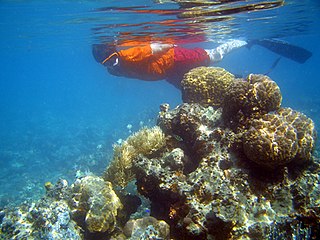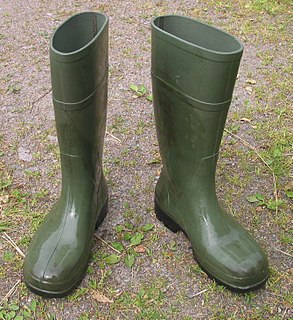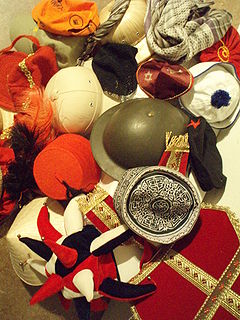
Snorkeling is the practice of swimming on or through a body of water while equipped with a diving mask, a shaped breathing tube called a snorkel, and usually swimfins. In cooler waters, a wetsuit may also be worn. Use of this equipment allows the snorkeler to observe underwater attractions for extended periods with relatively little effort and to breathe while face-down at the surface.

The Wellington boot was originally a type of leather boot adapted from Hessian boots, a style of military riding boot. They were worn and popularised by Arthur Wellesley, 1st Duke of Wellington. The "Wellington" boot became a staple of practical foot wear for the British aristocracy and middle class in the early 19th century. The name was subsequently given to waterproof boots made of rubber and they are no longer associated with a particular class. They are now commonly used for a range of agricultural and outdoors pursuits.

A diving suit is a garment or device designed to protect a diver from the underwater environment. A diving suit may also incorporate a breathing gas supply. but in most cases applies only to the environmental protective covering worn by the diver. The breathing gas supply is usually referred to separately. There is no generic term for the combination of suit and breathing apparatus alone. It is generally referred to as diving equipment or dive gear along with any other equipment necessary for the dive.

A facial is a family of skin care treatments for the face, including steam, exfoliation, extraction, creams, lotions, facial masks, peels, and massage. They are normally performed in beauty salons, but are also a common spa treatment. They are used for general skin health as well as for specific skin conditions. Types of facials include European facial, LED light therapy facials, hydrafacials and mini-facials.

A shower is a place in which a person bathes under a spray of typically warm or hot water. Indoors, there is a drain in the floor. Most showers have temperature, spray pressure and adjustable showerhead nozzle. The simplest showers have a swivelling nozzle aiming down on the user, while more complex showers have a showerhead connected to a hose that has a mounting bracket. This allows the showerer to hold the showerhead by hand to spray the water at different parts of their body. A shower can be installed in a small shower stall or bathtub with a plastic shower curtain or door. Showering is common in Western culture due to the efficiency of using it compared with a bathtub. Its use in hygiene is, therefore, common practice. A shower uses less water on average than a bath: 80 litres for a shower compared with 150 litres for a bath.

Smoking caps, also known as lounging caps, were Victorian headwear worn by men while smoking to stop their hair from smelling of tobacco smoke. They were soft caps, shaped like a squat cylinder or close fitting like a knit cap, and usually heavily embroidered with a tassel on top. They were originally worn for warmth, but continued with their new use after improvements in Victorian heating. They were popular in the period 1840-1880, and usually used by gentlemen in the privacy of their homes. The need for smoking caps, and smoking wear generally, arose from the social more of not smoking in front of women, and not smelling of smoke when one returned to their presence. They were often a gift from females, who made them themselves to give to male partners. They were often worn with a smoking jacket, but while the jacket was more or less de rigueur, the cap was optional. Neither was worn by everyone, as smoking was not as popular as it became in the twentieth century, although they could also be worn as part of a man's loungewear outfit with no connection to smoking. The decoration of the cap was often very ornate and colourful. Designs were Oriental influenced, especially designs from the Near and Middle East, a common Victorian influence in many other areas.
An oilskin is a waterproof garment, typically worn by sailors and by others in wet areas, such as fish-plant workers. The modern oilskin garment was developed by a New Zealander, Edward Le Roy, in 1898. Le Roy used worn-out sailcloth painted with a mixture of linseed oil and wax to produce a waterproof garment suitable to be worn on deck in foul-weather conditions. Oilskins are part of the range of protective clothing also known as foul weather gear.

Hair care is an overall term for hygiene and cosmetology involving the hair which grows from the human scalp, and to a lesser extent facial, pubic and other body hair. Hair care routines differ according to an individual's culture and the physical characteristics of one's hair. Hair may be colored, trimmed, shaved, plucked or otherwise removed with treatments such as waxing, sugaring and threading. Hair care services are offered in salons, barbershops and day spas, and products are available commercially for home use. Laser hair removal and electrolysis are also available, though these are provided by licensed professionals in medical offices or speciality spas.

The modern Irish Army uniform is based on the layer principle, and is designed to provide soldiers in the Irish Army with the right degree of protection for any operational environment.

Workwear is clothing worn for work, especially work that involves manual labour. Often those employed within trade industries elect to be outfitted in workwear because it is built to provide durability and safety.
Layered clothing is a term describing a way of dressing using many garments that are worn on top of each other. Some of the layers have different, largely non-overlapping, functions. Using more or fewer layers, or replacing one layer but not others, allows for flexible clothing to match the needs of each situation. Two thin layers can be warmer yet lighter than one thick layer, because the air trapped between layers serves as thermal insulation. Layered clothing is particularly relevant in cold climates, where clothing must at the same time transfer moisture, provide warmth, and protect from wind and rain. In a hot and dry climate, clothes have very different functional requirements: they must block the radiation from the sun, and allow for sufficient air circulation. Therefore, layered clothing in the sense used in this article is largely irrelevant in hot and dry climates. The wicking layer moves the sweat from your skin, where it can be absorbed by the other layers.

A fly mask or fly cap is a mask used on horses to cover the eyes, jaw, and sometimes the ears and muzzle to protect from flies. The mask is semi-transparent and made from a mesh allowing the horse to see and hear while wearing it. The mask may also provide some protection from UV-light and some are treated with insect repellent. Fly and mosquito protection is an important part of overall horse care, as biting insects are both a source of irritation and also may transmit disease.

The use of personal protective equipment (PPE) is inherent in the theory of universal precaution, which requires specialized clothing or equipment for the protection of individuals from hazard. The term is defined by the Occupational Safety and Health Administration (OSHA), which is responsible for PPE regulation, as the "equipment that protects employees from serious injury or illness resulting from contact with chemical, radiological, physical, electrical, mechanical, or other hazards." While there are common forms of PPEs such as gloves, eye shields, and respirators, the standard set in the OSHA definition indicates a wide coverage. This means that PPE involves a sizable range of equipment. There are several ways to classify them such as how gears could be physiological or environmental. The following list, however, sorts personal protective equipment according to function and body area.

The history of Italian fashion is a chronological record of the events and people that impacted and evolved Italian fashion into what it is today. From the Middle Ages, Italian fashion has been popular internationally, with cities in Italy producing textiles like velvet, silk, and wool. During the Middle Ages and Renaissance, Italian fashion for both men and women was extravagant and expensive, but the fashion industry declined during the industrialization of Italy. Many modern Italian fashion brands were founded in the late 19th and early 20th centuries, and in the 1950s and 1960s, Italian fashion regained popularity worldwide. While many clients of Italian fashion designers are celebrities, Italian fashion brands also focus on ready-to-wear clothes.

Headgear, headwear or headdress is the name given to any element of clothing which is worn on one's head.
Páramo Directional Clothing is a British outdoor clothing company. It was founded by Nick Brown, who also started the Nikwax waterproofing products company.

Traditional Inuit clothing is a complex system of cold-weather garments historically made from animal hide and fur, worn by the Inuit, a group of culturally related indigenous peoples inhabiting the Arctic areas of the United States, Canada, and Greenland. The basic components outfit consisted of a parka, pants, mittens, inner footwear, and outer boots. The most common sources of hide were caribou, seals, and seabirds, although other animals were used when available. Historically, the production of warm, durable clothing was an essential survival skill which was passed down from adult women to girls, and which could take years to master. Preparation of clothing was an intensive, weeks-long process that occurred on a yearly cycle following established hunting seasons. The creation and use of skin clothing was strongly intertwined with Inuit religious beliefs.














